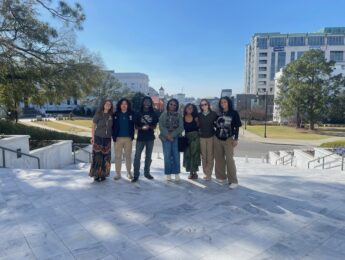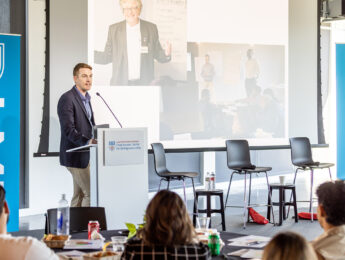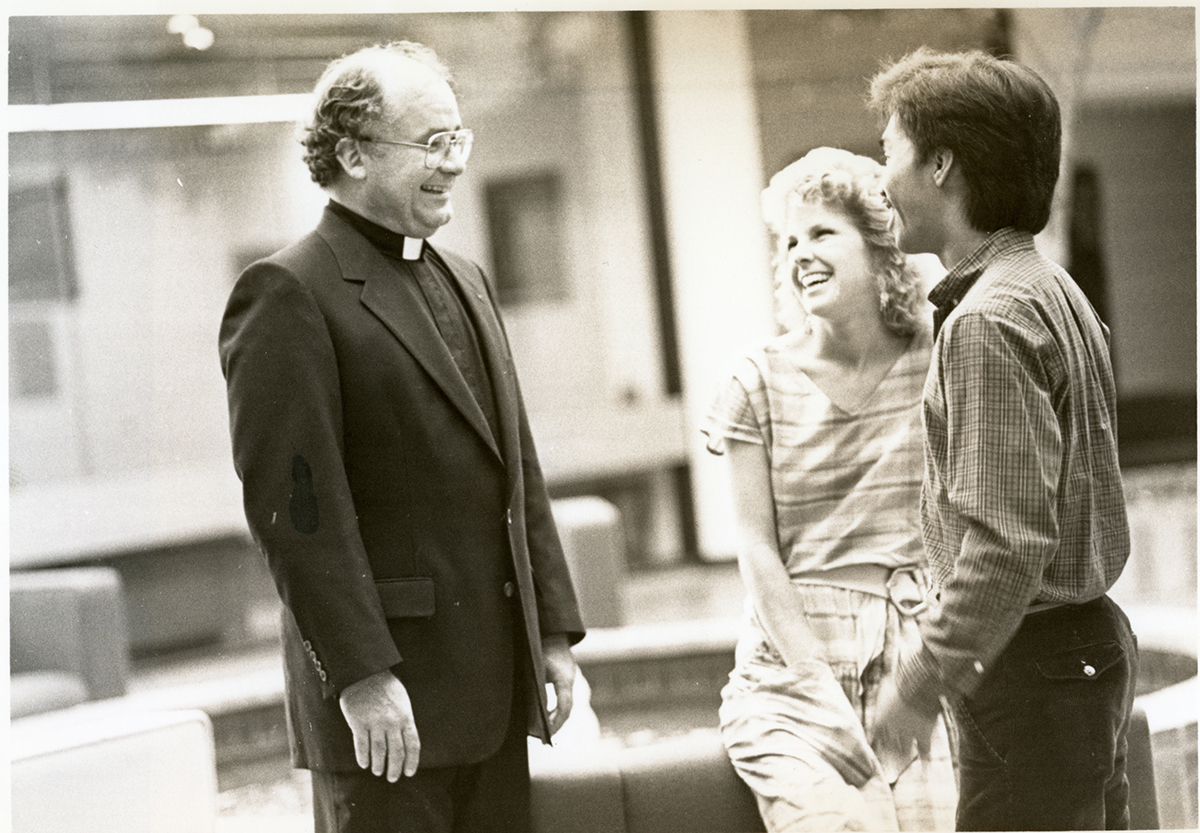
In 1986, Loyola Marymount University received an unexpected gift that would forever change the course of its history. Beverly Hills oil heiress Liliore Green Rains, the widow of a graduate of LMU Loyola Law School, passed away in November 1985, and when her will was executed, LMU learned she had bequeathed about $44 million to the university. At the time, it was the single largest gift in the university’s history, and the impact it would have on the growth and development of LMU would prove to be nothing less than seismic.
A Humble Teaching College
Professor Michael Genovese began teaching political science at LMU in 1980. He describes the university at that time as a humble regional teaching college where professors were primarily focused on high-quality undergraduate instruction. Genovese, who holds a doctoral degree from USC, planned to teach at LMU for two or three years and then move on to a more competitive institution. But shortly before Rains’ passing, the campus environment began to change.
In 1984, James N. Loughran, S.J., became the 12th president of LMU. Unlike previous LMU presidents, Loughran came from the East Coast and brought a different sensibility to his role. He introduced many ideas for how LMU could grow and elevate its reputation, including reducing faculty teaching loads from four classes per semester to three and adding the expectation that faculty do research and participate in national and international conferences. This movement toward a dynamic teacher-scholar model was designed to attract and develop more prominent faculty who would in turn increase the university’s visibility on the world stage.
In a jovial inauguration address delivered in 1985, the new president offered his vision for LMU: “We need to challenge the best in one another. No mindlessness or small-mindedness; too much is at stake. For I am convinced of this: the time is ripe for Loyola Marymount to secure and strengthen its position, in fact and reputation, as Los Angeles’ major Catholic university.”
Genovese was inspired by Loughran: “He did what great leaders do — he articulated a clear, forceful vision, and that vision was encapsulated in two words: academic excellence.” Among other faculty however, the new president’s ideas encountered stiff resistance. Some were deeply invested in their focus on teaching and reluctant to take on additional responsibilities. They also argued, correctly, that LMU simply did not have the funds to realize such ambitions. But in a stroke of incredible luck and timing, the Rains gift materialized in 1986, suddenly giving Loughran the resources to make his vision a reality.
A Mysterious Heiress
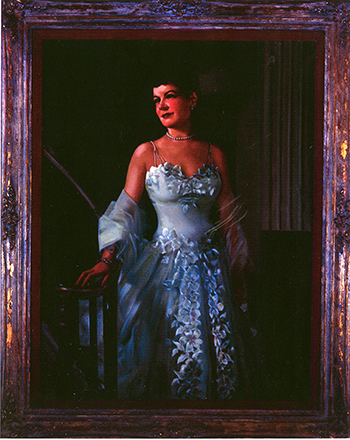
Liliore Green Rains was one of three daughters born to Burton Green, founder of the city of Beverly Hills and an oil and land development tycoon. As a young adult, she lived the life of a wealthy socialite, appearing at functions around Los Angeles, doing volunteer work, and donating generously to a variety of charities. Later in life, an undisclosed illness caused her to retreat from society and become more reclusive.
In 1947, she married noted lawyer William M. Rains, J.D. ’26, known for taking on many of the high-profile cases of the day, but he died of a heart attack less than two months after their marriage. Rains began giving to LMU in 1950, most likely spurred by a desire to honor her late husband; around that time, she made a contribution that established the William M. Rains Scholarship, still a major source of support for law students today.
Donald P. Merrifield, S.J., who was president of LMU from 1969 to 1984 and chancellor for several years after that, cultivated a warm relationship with Rains. Chancellor Michael Engh, S.J., got to know Merrifield while he was still a graduate student at LMU in the early 1980s. “Don was witty, outgoing, fascinating — a brilliant person,” Engh recalls. “He was one of those people who had a new idea every half hour. He knew a lot of L.A. people and worked hard to make contact.”
A regular visitor to Rains’ Beverly Hills estate, Merrifield enjoyed telling people that the reclusive widow kept a photo of him in a prominent place: in her entry hall, next to a picture of her favorite horse. Thanks in large part to their ongoing friendship, Rains would make several major gifts to LMU during her lifetime. In addition to the scholarships, her philanthropy supported, among other projects, the William M. Rains Library and the Merrifield Hall classroom building, both on the LMU Loyola Law School campus.
No one, however, was prepared for the massive 1986 bequest. Newspaper headlines trumpeted a “mystery bequest” from a “mysterious recluse.” LMU was one of six institutions to which Rains decided to leave the bulk of her $250 million fortune; the others were California Institute of Technology, Good Samaritan Hospital in L.A., Menninger Foundation in Kansas, Pomona College, and Stanford University. In the Los Angeles Times, a Stanford representative went on the record as having “no ties” to the benefactor while a Pomona representative exclaimed, “We don’t even know anybody to write a thank-you to.” Merrifield, who was close enough to Rains to call her “Lily,” knew a gift was coming, but even he was surprised by its magnitude.
A Vision of Academic Excellence
The impact of the Rains gift at that moment in LMU’s history cannot be underestimated. “The Rains money was the door that opened that allowed us to march through and achieve all that we achieved,” asserts Genovese. “It’s one thing to talk about greatness; it’s another thing to have the money to do it. Jim [Loughran] literally put his money where his mouth was.”
In the summer 1985 issue of VISTAS, then the alumni magazine of LMU, LMU Academic Vice President Albert P. Koppes, O. Carm., published a speech he had delivered to the Board of Trustees in which he laid out in detail the Loughran administration’s vision for the university. He was careful to acknowledge the excellence of the faculty, but firm in his insistence that LMU could be even better. He argued first for faculty development initiatives such as more aggressive recruitment of both lay and religious faculty, more frequent sabbaticals, more competitive salaries, and support for teaching assistants and better classrooms. Koppes called this “the heart of strengthening LMU” because it would help recruit higher quality students who would, in turn, elevate the university’s reputation. He also discussed the importance of “quality operations” and urged the improvement of campus facilities and the modernization of administrative systems.
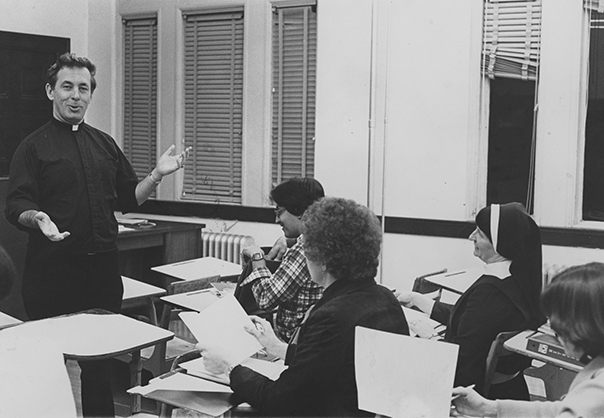
Koppes’ speech ended with a prescient plea: “We need to look at how we can get more money into academics. Action is tied to finances. No matter how we cut it, that is the reality. With that support, I can guarantee you that LMU will be the university in Los Angeles and Southern California.”
When the resources miraculously arrived less than a year later, Loughran and Koppes set out to methodically implement their vision, consulting closely with Genovese, whose academic specialty is leadership, and other progressive faculty members, such as liberal arts dean Anthony Brzoska, S.J., and history professor Lawrence Tritle. Koppes’ papers in the university archives reveal a long series of intense discussions with faculty in which they debated the exact meaning of the term “scholarship,” the scope of expectations that would be placed on faculty, and the university’s overall path forward.
By 1987, LMU’s report for WASC (Western Association of Schools and Colleges) accreditation listed a number of major improvements to faculty life, including reducing teaching loads to allow more time for research and travel, significantly increasing research budgets, doubling the frequency of sabbaticals, and expanding support for faculty retreats, professional development workshops, conference travel and participation, up-to-date computers, and other modern office equipment.
In 1989, Koppes’ Final Report on Scholarship described a new “symbiotic relationship” between teaching and scholarship: “Good teaching and good scholarship are inseparable; they are, in fact, parts of the same intellectual exercise. As a way of maintaining a commitment to academic excellence, the professor must develop his or her own insights into the material within a specific field of knowledge, not merely borrow the work of others.” Koppes went on to discuss the importance of faculty participating in larger scholarly discussions in their field and how “the national reputation of LMU is growing” because of it.
Genovese was so energized by these developments that he turned down several prestigious job offers to stay at LMU. “It was exciting, it was a place to be,” he enthuses. “Even our sports teams were great — the baseball team went to the College World Series in 1986 and in 1990 our basketball team went to the Elite 8 in the NCAA tournament. [The university was transforming into] one that people could and should be proud of. We became more ambitious, hungrier, more capable, more outward-looking.”
A Gift That Continues to Pay Dividends
Engh and Genovese agree that LMU’s rise to prominence as a premier national university began in earnest with the vision of Loughran, the hard work of Koppes and many faculty members, and the transformative gift from Rains. Supporting this perspective, LMU Executive Vice President and Provost Thomas Poon adds that the multiple endowments created by Rains’ bequest provide continuing support to key academic programs today, including undergraduate research and faculty research awards.
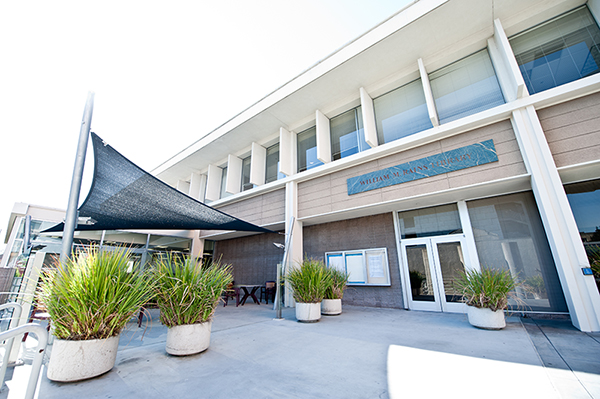
“Just as the Rains gift allowed us to focus on the importance of faculty research, it also allowed us to expand this to all undergraduates,” Poon says. “I believe it started with the honors program emphasizing how important it is to provide students of all majors with opportunities to engage in scholarly or creative works, in step with a national trend of recognizing the value of undergraduate research. Because of the Rains funds, we are able to offer the Summer Undergraduate Research Program (SURP), which provides a bevy of support to students interested in faculty-guided research and creative opportunities, and the Rains Research Assistant Program (RAINS), which funds more than 100 students a year to be research assistants to faculty. These are coveted positions, and they have transformed our undergraduate education.”
Rains’ support also enables the Provost’s Office to distribute over a million dollars in research funds every year to all the colleges. “Every dean gets a certain allocation from that amount, and then each dean gets to distribute that to their faculty,” explains Poon. “That could involve funding certain projects, going to conferences to present on their research, or going outside of LMU to access archives and collaborate with other researchers.”
The overall trajectory of excellence that was bolstered by the Rains bequest has continued in other ways. About a decade ago, LMU faculty decided to take the teacher-scholar model a step further by moving toward a four-unit curriculum instead of a three-unit curriculum, in which students would take fewer but more in-depth classes. The adjusted schedule would then allow faculty more time for research and conference travel. So far, two of LMU’s seven schools have converted completely to a four-unit curriculum.
Then, about five years ago, LMU moved from a Carnegie M1 Masters Colleges and Universities classification into the more prestigious Carnegie R2 Doctoral Universities (High Research Activity) classification. “That was a huge leap for us in recognition,” Poon remarks. “It’s really changed how the outside world sees us. Instead of being listed with regional institutions, we’re now listed with national universities.”
Reflecting on the overall impact of Rains’ gift, Poon suggests it has transformed the university writ large. “It didn’t just change one school or college,” he says. “It changed the entire university. I’ve been in higher education for 26 years, and in that time I’ve been at several different institutions, each of which has received many large gifts. But I have not seen — and certainly not experienced firsthand — the transformative power that the Rains gift has had at LMU.”
Igniting a Brighter World at LMU
As Liliore Green Rains’ gift continues to ignite LMU’s pursuit of academic excellence, it exemplifies the power of philanthropy to propel the university’s mission. LMU has a long history of strong philanthropic support that informs the university’s aspirations today. In our current strategic plan and comprehensive campaign, significant strides have been made to build upon the Rains legacy. Over the past five years, more than $155 million has been raised for academic programs, research, and faculty initiatives across LMU’s seven schools and colleges, and our goal is to increase that total to $250 million in the next five years. If you want to join LMU in igniting a brighter world through philanthropic support of academic programs, faculty, or research, please contact Senior Campaign Director Adrienne Wardenski ’04 at campaign@lmu.edu.



